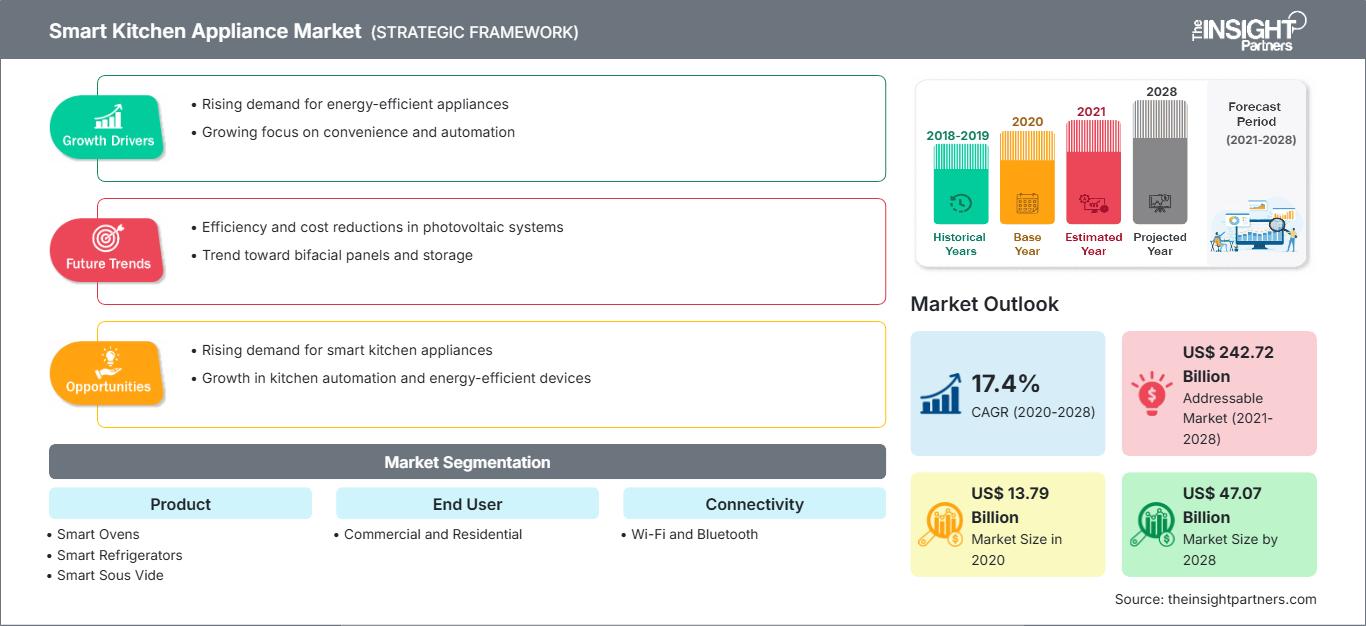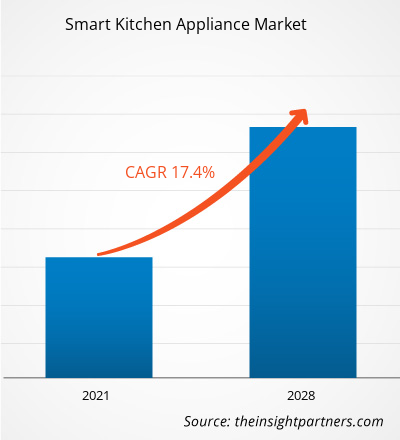글로벌 스마트 주방 가전 시장은 2020년 137억 8,600만 달러에서 2028년 470억 7,120만 달러로 성장할 것으로 예상되며, 2020년부터 2028년까지 연평균 성장률 17.4%를 기록할 것으로 예상됩니다.
스마트 주방 가전의 비용 효율성 및 통신 기능
스마트 주방 가전은 최근 혁신 기술로, 선진국과 개발도상국 모두에서 주목을 받고 있습니다. 시스코 인터넷 보고서에 따르면, 커넥티드 홈은 모든 사물 인터넷(IoT) 애플리케이션에서 48%의 점유율을 차지할 것으로 예상됩니다. 스마트 주방 가전은 비용 효율성, 통신 기능, 안전성, 편의성 등 여러 가지 이점을 제공하여 최종 사용자들 사이에서 인기를 얻고 있습니다.
스마트 주방 가전 구매를 위한 초기 투자 비용은 높은 편입니다. 하지만 이러한 가전제품은 장기적으로 정기적인 유지 관리 및 에너지 소비와 관련된 반복적인 비용을 줄이는 데 도움이 됩니다. 기존 전자제품이나 현대식 가전제품은 에너지 소비량은 적지만 정기적인 유지 관리가 필요하고 비용이 많이 듭니다. 스마트 주방 가전제품에 센서 기술을 통합하면 기기가 작동 상태를 감지하고 오류 발생 시 사용자에게 알림을 보낼 수 있습니다. 이를 통해 반복적인 비용이 절감됩니다. 예를 들어, LG전자는 스마트 가전제품용으로 제공하는 스마트폰 애플리케이션인 LG ThinQ를 제공합니다. 이 스마트 가전제품은 자가 진단 기능을 갖추고 있으며, 최종 사용자는 LG ThinQ 애플리케이션을 통해 진단 결과에 접근할 수 있습니다. 또한, 이 애플리케이션은 사용자에게 문제 진단에 필요한 문제 해결 지침을 제공하여 사소한 문제로 수리 담당자에게 연락할 필요가 없습니다. 반복적인 비용 절감으로 인해 많은 최종 사용자가 이러한 스마트 주방 가전제품을 구매하게 되었습니다. 마찬가지로, 스마트 주방 가전제품의 또 다른 장점은 무선 네트워크 통신 기능입니다. 이러한 주방 가전제품은 소유자의 스마트폰을 통해 서로 통신하고 소유자와도 통신할 수 있습니다. 스마트 기술을 통해 소유자는 원격으로 가전제품을 제어, 모니터링 및 접근할 수 있습니다. 스마트 오븐과 같은 스마트 주방 가전은 스마트폰으로 스토브를 켜고 끌 수 있도록 하여 편의성을 높여줍니다. 이러한 장점은 최종 사용자들의 수요를 증가시키고 있습니다. 또한, 다양한 센서와 내장 카메라를 탑재한 스마트 냉장고는 장보기 목록을 손쉽게 업데이트할 수 있도록 지원합니다. 스마트 냉장고에는 메모장처럼 사용할 수 있는 화면과 온도 및 에너지 소비 패턴을 확인할 수 있는 화면이 있습니다. 스마트 냉장고 사용자는 스마트폰을 통해 냉장고 성능에 따라 냉장고를 쉽게 제어하고 관리할 수 있으며, 다양한 모드로 전환할 수 있습니다. 이러한 스마트 냉장고의 장점 덕분에 상업용 및 가정용 스마트 냉장고를 구매할 수 있게 되어 스마트 주방 가전 시장 성장을 촉진하고 있습니다.
이 보고서의 일부, 국가 수준 분석, Excel 데이터 팩을 포함하여 모든 보고서에 대한 사용자 정의를 무료로 받을 수 있을 뿐만 아니라 스타트업 및 대학을 위한 훌륭한 제안 및 할인을 이용할 수 있습니다
스마트 주방 가전 시장: 전략적 통찰력

- 이 보고서의 주요 주요 시장 동향을 확인하세요.이 무료 샘플에는 시장 동향부터 추정 및 예측에 이르기까지 데이터 분석이 포함됩니다.
COVID-19 팬데믹이 스마트 주방 가전 시장에 미치는 영향
전자부품산업협회(Electronic Components Industry Association)에 따르면, COVID-19로 인해 공급망, 제품 출시, 행사 및 기타 산업 활동이 지연되고 차질이 발생했습니다. 여러 전자 제품 제조업체는 봉쇄 조치와 부품 및 원자재 공급 부족으로 인해 생산 시설을 일시적으로 중단해야 했습니다. 또한, 스마트 주방 가전을 포함한 다양한 전자 및 반도체 제품 제조업체는 예정된 일정이 지연되어 스마트 주방 가전 시장 공급망에 부정적인 영향을 미쳤습니다. 그러나 경제가 재개되고 2021년부터 시장이 긍정적인 모멘텀을 얻으면서 스마트 주방 가전 시장 공급망은 2020년 4분기 말부터 안정화되기 시작했습니다.
스마트 주방 가전 시장 분석
스마트 홈 및 스마트 호텔 프로젝트의 상당한 성장
글로벌 건설 부문은 기술적으로 진보된 가전제품 및 장치를 갖춘 커넥티드 홈에 대한 상당한 수요를 목격하고 있습니다. 미국, 영국과 같은 선진국과 중국, 일본, 한국과 같은 개발도상국은 스마트 홈 개발에 있어 흥미로운 진전을 이루었습니다. 미국 시장은 스마트 홈의 수가 상당히 증가했으며, 앞으로도 비슷한 추세를 경험할 것으로 예상됩니다. 미국 인구의 사고방식의 빠른 변화는 스마트 스피커, 스마트 온도 조절기, 스마트 조명, 스마트 보안 장치와 같은 스마트 가전 제품의 성장에 큰 영향을 미치고 있습니다. Alarm.org에 따르면 미국인의 57%는 스마트 제품을 사용하면 약 30분의 시간을 절약할 수 있다고 인정했습니다. 밀레니얼 세대의 약 47%가 스마트 홈 제품을 사용하고 있습니다. 이러한 기기의 도입은 미국과 전 세계적으로 지속적으로 증가하고 있습니다. 이러한 스마트 기기의 보급은 스마트 주방 가전 제품이 필수적인 가정 용품 중 하나이기 때문에 이러한 가전 제품의 성장 경로를 열어줍니다. 전 세계 인구, 특히 선진국과 일부 개발도상국의 사람들의 사고방식 변화로 인해 스마트 주방 가전의 미래가 더욱 주목을 받을 것으로 예상됩니다.
또한 다양한 지역의 호텔 업계는 고객 만족도 향상을 위해 로봇 기술과 커넥티드 기술을 도입하고 있습니다. 스마트 TV, 음성 제어 객실, 로봇 수하물 보관, 디지털 컨시어지 등은 현재 주목받는 스마트 호텔 기술 중 일부입니다. 여러 호텔 경영진은 스마트 주방 가전을 도입하여 주방을 스마트 주방으로 전환하는 데 상당한 관심을 보이고 있습니다. 클라우드 기반 기술과 스마트폰의 통합으로 호텔 및 레스토랑 소유주는 상업용 주방 가전을 원격으로 제어하고 모니터링할 수 있게 되었으며, 이는 현재 상황에서 스마트 주방 가전 시장의 발전을 촉진하고 있습니다.
제품 기반 시장 분석
제품을 기준으로 스마트 주방 가전 시장은 스마트 오븐, 스마트 냉장고, 스마트 수비드, 스마트 주서 및 블렌더, 스마트 쿠커 및 요리 로봇, 스마트 쿡탑, 스마트 및 통합 오븐 및 쿡탑 등. 스마트 냉장고 부문은 2020년에 33.0%의 점유율로 스마트 주방 가전 시장을 이끌었습니다. 스마트 주방 가전 시장은 선진국과 개발도상국에서 스마트 냉장고와 스마트 오븐에 대한 수요가 급증하고, 라이프스타일이 개선되고, 인터넷 인프라가 개선되고, 사물 인터넷(IoT)이 크게 성장하고, 주거 및 상업용 주방에서 연결된 장치나 가전제품에 대한 수요가 증가함에 따라 급증하고 있습니다.
스마트 냉장고 부문은 2018년에 글로벌 스마트 주방 가전 시장에서 가장 큰 점유율을 차지했으며 2021~2028년에도 시장을 지배할 것으로 예상됩니다. 반면, 스마트 오븐에 대한 수요는 수년에 걸쳐 크게 증가할 것으로 예상되므로 2021년부터 2028년까지 이 부문의 미래가 밝을 것으로 예상됩니다.
연결성 기반 시장 통찰력
연결성을 기준으로 스마트 주방 가전 시장은 Wi-Fi와 Bluetooth로 구분됩니다. Wi-Fi 부문은 2020년 77.3%의 점유율로 스마트 주방 가전 시장을 주도했습니다. 2028년까지는 79.0%의 점유율을 기록할 것으로 예상됩니다.
주방 가전은 첨단 센서, 인터랙티브 디스플레이 패널, 카메라 및 기타 기술의 융합으로 점점 더 지능화되고 있습니다. 이러한 기술의 통합은 제조업체가 상당한 고객 유치와 매출 증대를 달성하는 데 도움이 되었습니다. 이를 통해 제조업체는 Wi-Fi 연결 기술과 같은 추가 기술로 제품 라인을 업그레이드할 수 있었습니다.
Wi-Fi는 오늘날 모든 지역에서 필수적인 가정 구성 요소가 되었습니다. 스마트 주방 가전 제조업체는 사용자가 원격으로 조리 기기를 작동하고 모니터링할 수 있도록 Wi-Fi 지원 연결 기술 솔루션을 제품에 통합하는 추세입니다. Wi-Fi 지원 스마트 조리 기기를 통해 사용자는 온도와 시간이라는 두 가지 주요 매개변수를 제어하고 모니터링할 수 있습니다. 이러한 이점은 가정 및 상업 최종 사용자가 Wi-Fi 연결 기술을 갖춘 스마트 주방 가전을 구매하도록 유도했습니다. 구매 증가는 시장 성장으로 이어졌습니다. 급속도로 발전하는 인터넷 인프라는 Wi-Fi 지원 스마트 주방 가전의 성장에 중요한 역할을 합니다. 시스코 연례 인터넷 보고서에 따르면 IoT 기기는 전체 네트워크 기기의 50%를 차지할 것이며, 그중 약 3분의 1은 무선 기기가 될 것으로 예상됩니다. 이러한 요인은 향후 Wi-Fi 연결 기술을 탑재한 스마트 주방 가전의 성장을 촉진할 것으로 예상됩니다. 스마트 오븐, 스마트 냉장고, 스마트 쿡탑, 스마트 커피 자판기, 스마트 주스기 및 블렌더는 시중에 출시된 Wi-Fi 지원 스마트 주방 가전 중 일부입니다. 주방 가전에 Wi-Fi 연결 기술을 통합하려는 소비자들의 요구가 증가함에 따라 스마트 주방 가전에 Wi-Fi 연결 기술이 통합되는 추세가 가속화되고 있습니다. 이러한 요인은 현재 Wi-Fi 지원 스마트 주방 가전 시장의 핵심 성장 동력입니다. 스마트 주방 가전
스마트 주방 가전 시장 지역별 분석
The Insight Partners의 분석가들은 예측 기간 동안 스마트 주방 가전 시장에 영향을 미치는 지역별 동향과 요인들을 면밀히 분석했습니다. 이 섹션에서는 북미, 유럽, 아시아 태평양, 중동 및 아프리카, 그리고 중남미 지역의 스마트 주방 가전 시장 세분화 및 지역별 현황도 살펴봅니다.
스마트 주방 가전 시장 보고서 범위
| 보고서 속성 | 세부 |
|---|---|
| 시장 규모 2020 | US$ 13.79 Billion |
| 시장규모별 2028 | US$ 47.07 Billion |
| 글로벌 CAGR (2020 - 2028) | 17.4% |
| 이전 데이터 | 2018-2019 |
| 예측 기간 | 2021-2028 |
| 다루는 세그먼트 |
By 제품
|
| 포함된 지역 및 국가 | 북미
|
| 시장 선도 기업 및 주요 회사 프로필 |
|
스마트 주방 가전 시장 참여자 밀도: 비즈니스 역학에 미치는 영향 이해
스마트 주방 가전 시장은 소비자 선호도 변화, 기술 발전, 그리고 제품의 장점에 대한 인식 제고 등의 요인으로 인해 최종 사용자 수요가 증가함에 따라 빠르게 성장하고 있습니다. 수요가 증가함에 따라 기업들은 제품 라인업을 확장하고, 소비자 니즈를 충족하기 위한 혁신을 추진하며, 새로운 트렌드를 적극 활용하고 있으며, 이는 시장 성장을 더욱 가속화하고 있습니다.

- 을 얻으세요 스마트 주방 가전 시장 주요 주요 플레이어 개요
스마트 주방 가전 시장에서 활동하는 기업들은 시장 내 입지를 유지하기 위해 인수, 합병, 시장 이니셔티브와 같은 전략을 채택합니다. 주요 기업들의 몇 가지 개발 사례는 다음과 같습니다.
- 2019년 11월, Electrolux는 Google과의 협력을 확대하여 유럽의 커넥티드 주방 제품에 Google Assistant를 통합하여 소비자가 음성 명령으로 제품을 제어할 수 있도록 했습니다.
글로벌 스마트 주방 가전 시장은 제품, 최종 사용자, 연결성으로 구분됩니다. 제품 기준으로 스마트 주방 가전 시장은 스마트 오븐, 스마트 냉장고, 스마트 수비드, 스마트 주서 및 블렌더, 스마트 쿠커 및 조리 로봇, 스마트 쿡탑, 스마트 및 통합 오븐 및 쿡탑 등으로 구분됩니다. 최종 사용자 기준으로 시장은 상업용 및 주거용으로 분류됩니다. 연결성 기준으로 스마트 주방 가전 시장은 Wi-Fi와 Bluetooth로 구분됩니다.
Electrolux AB; BSH Hausgeräte GmbH, GE Appliances, LG Electronics, Koninklijke Philips NV, Panasonic Corporation, Samsung Electronics Co., Ltd, Breville Group Limited, Whirlpool Corporation, Vita-Mix Corporation은 본 연구 조사 대상 스마트 주방 가전 시장의 주요 기업입니다. 또한, 본 연구 보고서에서는 전 세계 스마트 주방 가전 시장과 생태계에 대한 전체적인 관점을 얻기 위해 다른 주요 스마트 주방 가전 시장 기업 몇 곳도 조사 및 분석했습니다.
- 과거 분석(2년), 기준 연도, CAGR을 포함한 예측(7년)
- PEST 및 SWOT 분석
- 시장 규모 가치/거래량 - 글로벌, 지역, 국가
- 산업 및 경쟁 환경
- Excel 데이터세트
최근 보고서
사용 후기
구매 이유
- 정보에 기반한 의사 결정
- 시장 역학 이해
- 경쟁 분석
- 고객 인사이트
- 시장 예측
- 위험 완화
- 전략 기획
- 투자 타당성 분석
- 신흥 시장 파악
- 마케팅 전략 강화
- 운영 효율성 향상
- 규제 동향에 발맞춰 대응




















 무료 샘플 받기 - 스마트 주방 가전 시장
무료 샘플 받기 - 스마트 주방 가전 시장